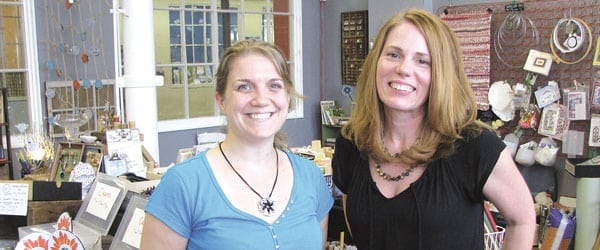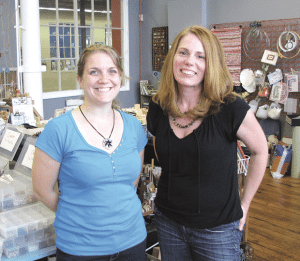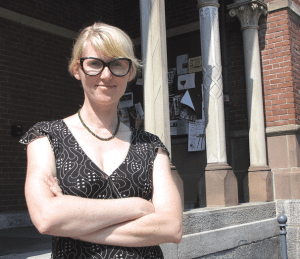
Making a Scene
Easthampton Becomes a Mecca for Creative Businesses

Knack, which Amber Ladley, left, and Macey Faiella recently opened at Eastworks, is just one of hundreds of creative businesses and artists that call Easthampton home.
The shop — which showcases and sells work primarily by local painters, sculptors, and other creative folks — has called the address home for almost two decades, said its owner, Marlies Stoddard, or since her mother opened the gallery 18 years ago.
“She had no background in art, no retail background,” Stoddard told BusinessWest. “But she owned the building, and she was sick of tenants moving in, painting the place purple, and moving out after six months after paying only three months rent.”
At the time, her mother saw Easthampton as “an old mill town with empty storefronts,” but she did recognize the Cottage Street area as home to a growing cluster of artists, and saw potential in catering to that scene.
Through the intervening years, Stoddard said, as artists throughout New England were beginning to recognize the city’s creative scene, it remained under the radar for many locals. “Everyone else was looking in on Easthampton and saying, ‘wow, what a place you have; what a mesh of blue collar and the arts.’ But often, the local townie doesn’t necessarily see it.”
That image is gradually changing, however, as Easthampton is cultivating a reputation as a thriving cultural mecca, with artists and creative entrepreneurs at the forefront of a creative-economy sector that is benefiting businesses of all types.

Burns Maxey says municipal leaders and businesses have increasingly come to value what the arts bring to Easthampton.
“We get an average of 350 to 500 people coming out for the art walk,” said Burns Maxey, coordinator of Easthampton City Arts+ (ECA), a quasi-public organization tasked with consolidating and promoting the local creative economy. “It started off as a way to bring people to the city, by having all the exhibitions open. Since then, we’ve added themes to each art walk.”
For instance, last month’s walk was subtitled “Sights & Sounds” and featured more than 15 musicians and performers busking on Union Street. The history-themed Oct. 12 walk is dubbed “Know Thy Past.”
“Some restaurants have exhibitions or gallery space, or host performances or musicians or readings, and it really activates the whole city,” Maxey said. “There’s a buzz about what’s going on.”
Stoddard said she was involved in managing the monthly walk before ECA took it over. “It was great because we transformed these non-traditional venues. If you’re a coffee shop or whatever, you can be an art venue for three hours and have fun getting people through the doors. If you’re an insurance agency by day, for three hours on Saturday, you could be a gallery. People had a lot of fun with the Art Walk, and it’s still really thriving.”
‘Thriving’ would be an accurate term to describe both the creative culture in Easthampton and the efforts of ECA to leverage them into an effective force for economic development. For this issue, BusinessWest sits down with Maxey and several local business people to discuss why this city’s arts scene is being held up as an example for other communities to emulate.
Grin and Bear It
Easthampton City Arts began in 2005 as a group of artists and business owners who recognized the impressive number of creative people working in Easthampton and saw opportunities for revitalization efforts stemming from promotion of the arts. The + was added to the name several years later to reflect increasing participation from neighboring Southampton and Westhampton.
Before ECA, Maxey said, “Easthampton had a lot of storefronts that didn’t have businesses in them. This was a potential economy they could tap into.
“A lot of things happened between that time and now,” she continued. ECA received an Adams Arts grant from the Mass. Cultural Council, which looks for projects that work toward community-revitalization efforts through the creative economy. A coordinator was hired, Maxey said, and one of the first things she did was map out the city’s creative assets. “And there was a lot going on under the surface.”
For example, more than 100 creative businesses, the vast majority of them solo artists, call the sprawling Eastworks complex home, and more than 60 others are located along the Cottage Street corridor.
“That was the starting point,” Maxey said. “They created a directory, and also an online directory, for all these artists and creative businesses. That was really the first stepping stone.”
Another key development was the success of Bear Fest in 2009, when life-sized, fiberglass bears were painted and otherwise decorated by a host of artists and displayed outdoors, throughout the downtown area, for public viewing. Another Bear Fest followed in 2012.
“Doing Bear Fest was huge because it showed not only that Easthampton has the potential for being a destination for people to visit, but businesses saw the impact of people coming to Easthampton. That was a major step,” she said.
“I think businesses questioned it, at first,” she continued, “but when they saw so many people — thousands of people came through the city the first day alone — they really saw the potential.”
Since then, Maxey said, that spirit has reverberated in many public events and projects centered on the arts.

Jean-Pierre Pache says the city’s growing profile as an arts mecca has attracted more businesses and residents.
Jean-Pierre Pache was the first tenant in the remodeled building, moving Eastmont Custom Framing — a business he started in 2001 — as well as a small art studio, to the historic property. As one of the more than 240 artists active with ECA, he said he has seen the town’s creative community boost more than just its own profile.
“I think what’s more important is that the whole city has changed,” he said. “The city has a different image, which attracts visitors, which attracts new businesses and even new residents.”
He insists that such progress has been greatly enhanced by ECA’s efforts to more prominently position the arts and the creative economy as one of the town’s core strengths.
“I’ve seen the differences; in 12 years, I’ve been able to witness a lot of changes,” said Pache. “It was happening before I got here, and it’s still happening now, but there’s a lot of momentum now. That’s one of the strengths of ECA, and I give them a lot of credit.”
He noted that Meri Jenkins, program manager of the state’s Adams Arts Program, has often held up ECA as an example to other fledgling groups of not only effectiveness, but longevity.
“Many [arts organizations] suffer from burnout, since they’re all volunteer-based,” Pache said. “But this keeps growing and reinventing itself and finding new energy. We’re very lucky to have this in our town.”
Maxey agrees. “My position is through the Planning Department, and it makes a huge difference when you have a person tasked with looking at the creative-economy efforts. It’s economic development, but a creative way of looking at it.”
Added Stoddard, “we’re really lucky the city is putting value in this. A lot of us have been working very hard, and Burns is very much our leader.”
Knack for Business
Former mill complexes like Eastworks and Paragon Arts and Industry, both located on Pleasant Street, as well as One Cottage Street, have become home to vibrant artist communities. Amber Ladley and Macey Faiella saw the potential of Eastworks when they conceived of Knack, the ‘creative-reuse’ store they opened in the complex over the summer.
“We’ve gotten an amazing, fantastic response. The community itself has been very welcoming,” said Ladley, noting that the pair met Maxey early on, and met other artists through networking events organized by ECA.
“Through all that, we knew we wanted to be in Easthampton or Northampton. We still looked all throughout the Pioneer Valley; we really wanted to have a convenient location with parking, and we looked all over the place. When we saw this space in Eastworks, we felt it was the right space, and that Easthampton would be a good area for us.”
Ladley and Faiella, each the mother of two boys, were Easthampton residents when they met about 10 years ago. When Ladley read an article about creative reuse, she and Faiella began talking about a business that deals in reusable, ‘upcycled’ materials for creative projects.
“I knew Macey is very thrifty, always finding fun stuff at the side of the road and decorating her house with it,” Ladley said. “We started chatting and loved the idea, so we kept going.”
Faiella said she was surprised that such a store — which caters to all ages, from young crafters and Pinterest-obsessed teens to idea-seeking teachers and senior citizens with creative hobbies — didn’t exist in the Pioneer Valley, with its emphasis on all things ‘green.’
“In such an artsy community, it seemed like a perfect fit,” she said. “Everything is donated, much of it from artists in the area — we’re lucky to be in an area where artists are everywhere. A lot of it is from people cleaning out their closets, moving on to different hobbies. A kitchen-remodeling company was going out of business and had tile samples they were going to throw away in the dumpster; we saw the potential for them.”
The shop simply oozes inspiration. When a registry of deeds donated some microfilm reels, they were turned into cupcake stands. One woman bought a collection of rusty wrenches with the intention of turning them into wind chimes.
“We have great things for kids to use, and when people walk in, even if they’re not a crafter or creative person, they’ll still find stuff they want to do,” Faiella said, adding that a recent Art Walk saw about 70 people stop by. “People are really craving that kind of thing and getting more involved in the arts and what’s available. It’s been a nice fit for us, and we definitely feel that vibe — that this is a town that supports that kind of thing.”
To bring more such life to Eastworks, the complex is partnering with ECA on an endeavor called MAP, or the Mill Arts Project. “We’re working together to offer space to artists or creative people or creative business owners who want to try out an idea for a month or two,” Maxey explained.
“It could be a pop-up shop, it could be a performance space or an exhibition space, and we give them educational tools for how to connect with businesses and how to market their work,” she continued. As part of the deal, “they have to be open a certain number of hours or have events open to the public. It’s really a learning tool, and hopefully it will show them the potential to perhaps open a business or continue their idea in the city, particularly in Eastworks.”
Cottage Industry
Meanwhile, the Cottage Street neighborhood continues to thrive with its eclectic mix of enterprises, from Luthier’s Co-Op, where patrons can buy stringed instruments, take in live music, and drink a local brew; to New England Felting Supply, which offers workshops inside its brightly colored walls; to Popcorn Noir, a restaurant, bar, and performance space that also hosts mixology classes.
“It’s interesting because there were so many empty storefronts in that location, but in the last couple of years, it’s filled up quickly,” Maxey said. “There’s an immense amount of art-making happening. These are people who have small businesses; they’re making money from it, but they’re not the typical businesses we’ve thought about for so long since the 1950, like shoe stores and investment companies — although those are there, too.”
Meanwhile, Stoddard is currently sponsoring the sixth annual Paint Out, a project for which local artists paint outdoor scenes from around Easthampton, which will be displayed and put up for sale.
“We have around 55 painters, which is really great,” she said. “It creates this snowball effect, where people driving by turn their heads and say, ‘what’s going on here?’ when they see four or five painters set up in the same field. It creates a sense of wonder. And we have such an incredible wealth of local artists.”
Successful events are springing up elsewhere as well, such as the second annual Art in the Orchard running through October at Park Hill Orchard, featuring temporary installations from 22 sculptors — and a schedule of music and dance performances — throughout the grounds during prime apple-picking season.
“The location is stunning, the art is compelling, and that appeals to a lot of different people, from toddlers to grandparents,” said Pache, who is organizing the event, adding that between 100 and 150 visitors stop by on a typical day. “The art is supporting the orchard, and the orchard supports the arts at the same time. It provides a very unusual setting for the artwork.”
Speaking of live performances, Maxey said ECA is trying to raise the profile of such events in Easthampton by building an online database of venues. “Anyone can come to it and research where to hold an event. We’re excited to put that together.”
She credits much of her organization’s success to the enthusiasm of the local arts community, noting that the 240 artists who call themselves ECA members are probably only a fraction of the total working locally.
“This is a tight-knit community, and people are excited about what’s going on here,” she told BusinessWest. “I moved here from Northampton in 2007 and immediately fell in love with Easthampton because of the community of people.”
Stoddard noted multiple reasons why Easthampton is an attractive landing spot for artists and creative business people. “We have endless real estate for studio space, and we have a large body of people who come here and appreciate their anonymity — and we respect that as well.”
Maxey added that “there is absolutely a buzz about what’s going on here. I think the quality of the artists in this location — in Easthampton and the Pioneer Valley as a whole — is immense. Go outside our area, and you can really recognize the quality of art made right here — that’s everyone from artisans to fine artists; performers to sculptors and installation artists. There’s a little bit of everything. We have a great community here.”
No Place Like Home
Stoddard said thriving business districts have a societal benefit that can be long-lasting, and creative enterprises have driven much of the recent growth in Easthampton.
“I have customers coming in with their kids and actively teaching them the values of shopping locally and supporting their local downtown,” she said. “That mentality has really changed — the appreciation for small businesses. I feel it all the time; I never feel slighted. I constantly have people coming in saying, ‘thank you for being here.’
“It’s a great feeling, and it makes being a business person in my hometown really rewarding,” she concluded. “I didn’t have that feeling back in 1995. When I was 18, I wanted to get out of here. But it’s a great place to come back to.”
Joseph Bednar can be reached at [email protected]




